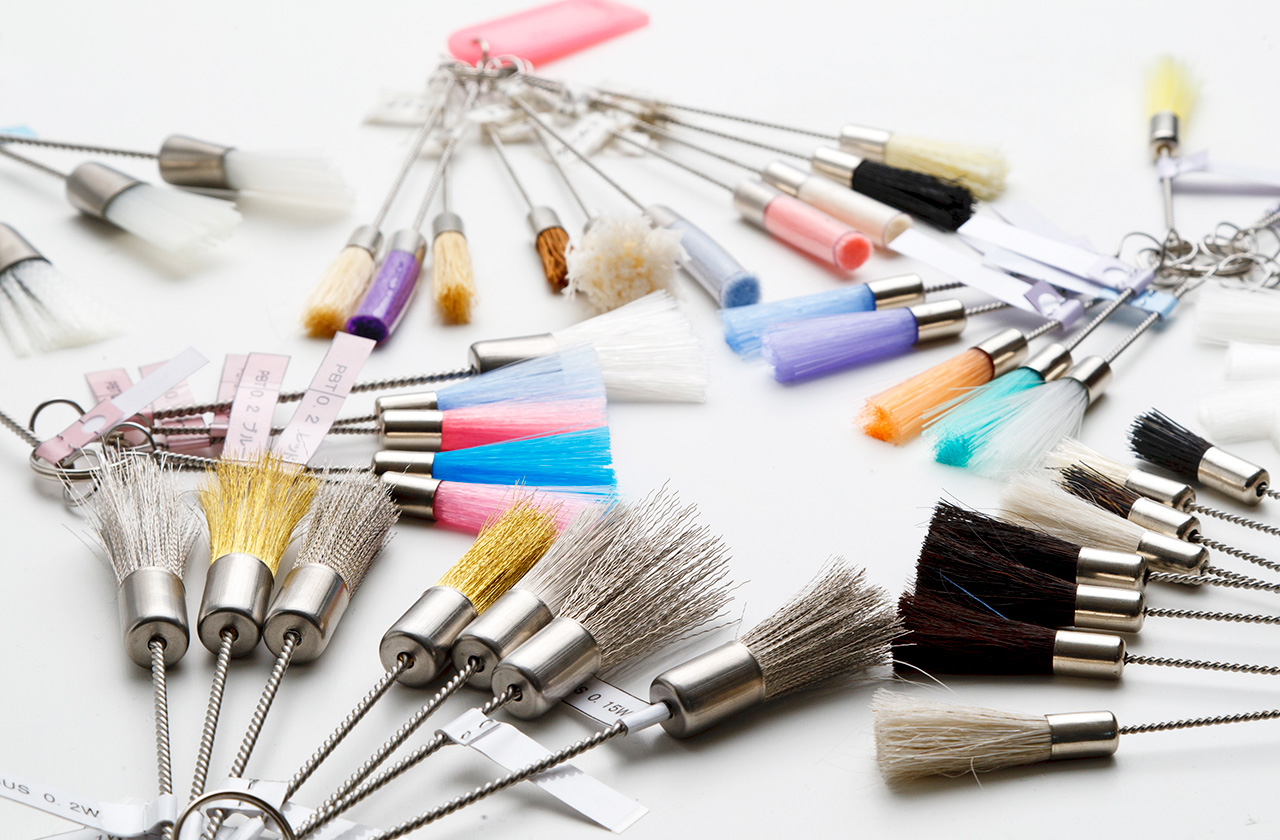We support various materials not only for hair materials but also for core wires, so we can propose twisting brushes according to the customer’s application. We also support hair materials not listed on this site, so please feel free to contact us.

Chemical fiber (nylon / abrasive nylon / PP / PPS / PET / PBT)
Animal hair (black hair / white hair / black swing hair / white swing hair / black pig hair / white pig hair / goat hair)
Plant fiber (palm / packing / sisal)
Metal wire (stainless steel / brass)
* It may not be possible to manufacture depending on the size and combination of diameters.
Brush hair material
| Product name | Features / Physical characteristics | Melting point | Usage limit | Water absorption rate (%) | specific gravity | |
|---|---|---|---|---|---|---|
| Chemical fiber | 6 nylon | Among the chemical fibers, it has excellent wear resistance, elasticity, flexibility, and excellent durability. Although it is weak against strong acids, it is not easily affected by chemicals including alkalis, and it is durable against gasoline, oil, detergents, etc. It is used as many brush materials. There are abundant wire diameters of Φ0.063 to Φ1.0 or more. | 215°C | 100°C | 3.5~5.0 | 1.14 |
| 66 nylon | 255°C | 120°C | 3.5~5.0 | |||
| 610 nylon | 214°C | 100°C | 1.8~2.0 | 1.08 | ||
| 612 nylon | 213°C | 100°C | 1.8~2.0 | 1.06 | ||
| Abrasive nylon (Grit nylon) |
A wire rod made by mixing abrasive grains (alumina oxide, silicon carbide, diamond powder) into nylon material and processing the filament, and has excellent polishing power. Others are almost the same as nylon. Toray = Tregrid / DuPont = Tinex A / Asahi Kasei = Sangrid |
|||||
| Polypropylene PP | Almost unaffected by acidity and alkalinity. It is harder and stronger than nylon, but it is not recoverable if it has hair habits. The tips of the hair are torn vertically due to impact. |
|||||
| Polyester PET | It has excellent chemical resistance and heat resistance compared to nylon and polypropylene PP. Melting point = 260 °C Usage limit = 140 °C Harder than nylon and stiffer, but more prone to hair habits. |
|||||
| Animal hair | Horsehair | It has slightly better chemical resistance than chemical fibers. It is flexible and elastic, and static electricity is unlikely to occur. Since it is a natural fiber, the thickness is not constant, but hair materials with different parts are used depending on the intended use. Real hair = hard swing hair = soft | ||||
| Pig hair | It has flexibility and elasticity, and has strong hairiness in animal hair. There is a limit to the length because it is a natural fiber. | |||||
| Goat wool | The hair is softer and softer than horsehair and pig hair. Hair breakage is likely to occur because the fibers are thin. | |||||
| Plant fiber | Paquin | A fiber taken from the leaves of Tampico hemp, which has excellent water absorption, detergency, and polishing power. | ||||
| Palm | It is a fiber made from palm nuts and has excellent water absorption and detergency, and is soft and elastic. | |||||
| Sisal | It is a fiber taken from hemp and has excellent polishing power. | |||||
| Metal wire | Stainless wire SUS 304 |
It has excellent chemical resistance and heat resistance, and does not generate rust. Processing with thin wires with a wire diameter of Φ0.06 or higher is also possible. | ||||
| Brass wire | Compared to hard steel wire and stainless steel wire, the hair is softer and has a softer finish. | |||||
| Hard steel wire SW |
It is often used in industrial brushes. However, rusting and hair breakage due to metal fatigue occur. Carbon content = 40C-80C | |||||
Nylon with abrasives by manufacturer
| Toray (TG-N610) | |||||
|---|---|---|---|---|---|
| Abrasive material | Thread diameter (mm) | Abrasive grain count (#) | Abrasive material | Thread diameter (mm) | Abrasive grain count (#) |
| Aluminium Oxide | 0.3 | 600 | Silicon Carbid | 0.2 | 1000 |
| 0.45 | 500 | 0.3 | 600 | ||
| 0.6 | 320 | 0.45 | 500 | ||
| 0.9 | 240 | 0.6 | 320 | ||
| 1.05 | 180 | 0.9 | 240 | ||
| 1.2 | 80 | 1.05 | 180 | ||
| 1.2 | 120 | ||||
| DuPont (TX-N612) | |||||
|---|---|---|---|---|---|
| Abrasive material | Thread diameter (mm) | Abrasive grain count (#) | Abrasive material | Thread diameter (mm) | Abrasive grain count (#) |
| Aluminium Oxide | 0.3 | 600 | Silicon Carbid | 0.45 | 500 |
| 0.45 | 500 | 0.55 | 320 | ||
| 0.6 | 320 | 0.75 | 240 | ||
| 0.9 | 240 | 0.875 | 180 | ||
| 1.05 | 180 | 1 | 120 | ||
| 1.2 | 80 | 1 | 80 | ||
| 1.2 | 60 | ||||
| Asahi Kasei (SG-N612・6) | |||||
|---|---|---|---|---|---|
| Abrasive material | Thread diameter (mm) | Abrasive grain count (#) | Abrasive material | Thread diameter (mm) | Abrasive grain count (#) |
| Aluminium Oxide | 0.2 | 100 | Silicon Carbid | 0.45 | 500 |
| 0.3 | 600 | 0.6 | 320 | ||
| 0.45 | 500 | 0.9 | 240 | ||
| 0.6 | 320 | 1 | 180 | ||
| 0.9 | 240 | 1.2 | 120 | ||
| 1 | 180 | 1.2 | 80 | ||
| 1.2 | 80 | 1.5 | 80 | ||
